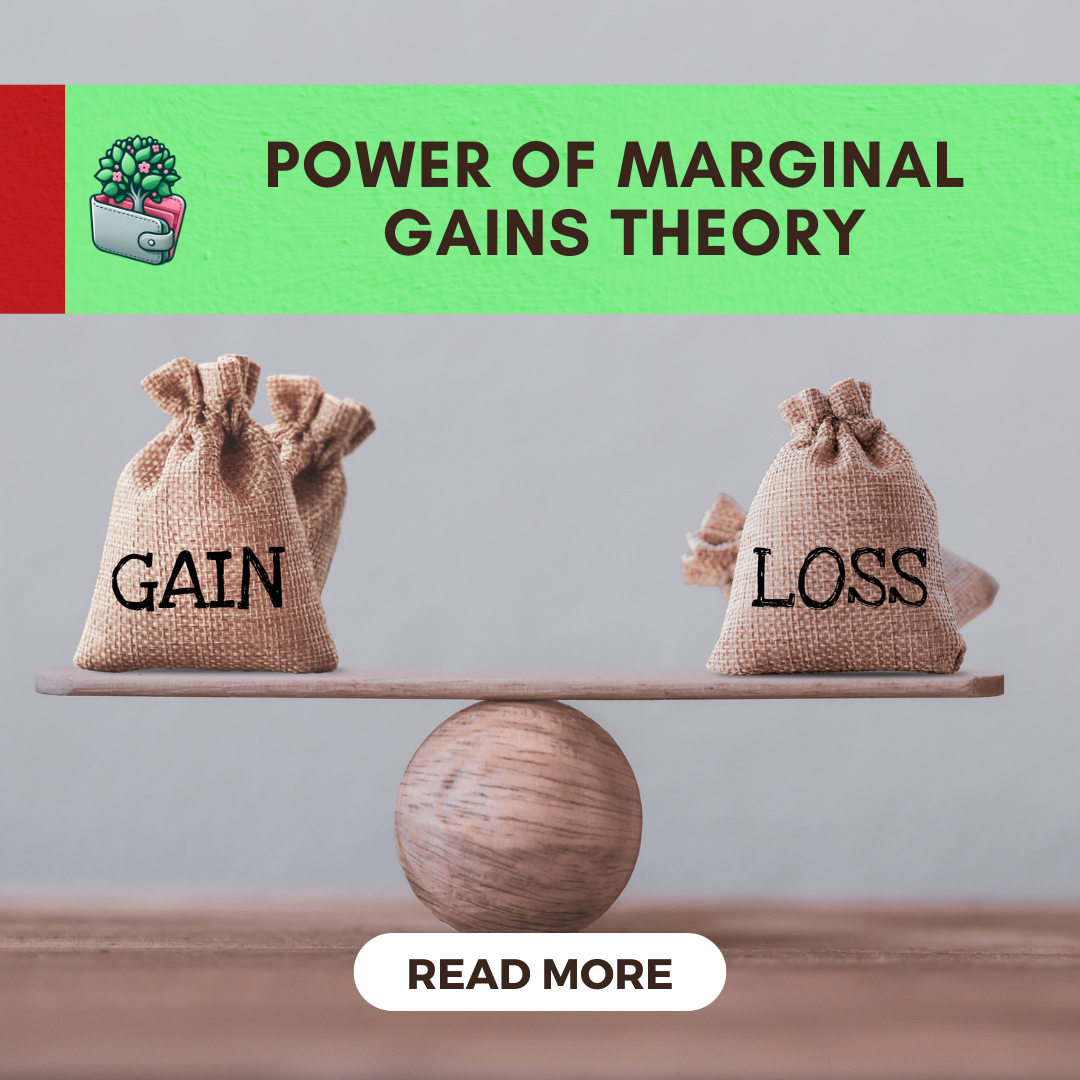Building a secure and free future can feel like climbing Mount Everest – one step at a time. But what if I told you consistent, bite-sized improvements could be the secret weapon you’ve been missing?
In this article, we’ll delve into the Power of Marginal Gains Theory, a powerful concept used by titans of industry and everyday heroes alike. We’ll explore how focusing on small, measurable improvements across various aspects of your finances can lead to significant results over time.
Think of it as chipping away at that financial mountain, one smart choice at a time.

The Origins of Marginal Gains Theory
Picture this: the British Professional Cycling Team was stuck in a rut, with only one gold medal to their name and zero Tour de France victories. It was a century-long struggle of mediocrity. But performance director Sir Dave and his team had a vision.
They believed that by making tiny improvements in every aspect of their training and lifestyle, they could turn the tide. And boy, did they ever!
How the British Cycling Team Dominated with Marginal Gains
The approach of the British Cycling Team was all about finding those small, seemingly insignificant areas where they could make a 1% improvement. They left no stone unturned, optimizing everything from nutrition and training methods to bike ergonomics.
The British Cycling Team dominated and even looked at things like pillow selection, hand-washing techniques, and the type of massage gel used. Each of these tiny tweaks might seem trivial on its own, but when combined, they led to a massive boost in the performance of each British cyclist. Brailsford called it the aggregation of marginal gains.
And guess what? They started dominating the sport, racking up gold medals and Tour de France victories like never before.

What is Marginal Gains Theory?
The marginal gains philosophy is rooted in the idea that small, incremental improvements can lead to significant changes over time. Think about it: if you improve by just 1% each day, by the end of the year, you’ll be 37 times better than when you started.
On the flip side, if you decline by 1% each day, you’ll find yourself in a pretty bad spot. The concept of marginal gains can be applied to many areas, including:
Sports
In sports, this means focusing on optimizing every aspect of an athlete’s performance, from training and equipment to nutrition and mental preparation. For example, the Maasin City Cycling Club in the Philippines applies this by closely examining factors like diet, sleep, and training routines to identify areas where even the tiniest improvements can lead to increased speed and endurance
Business
In business, this means focusing on making minor adjustments to processes, products, or services to optimize performance. By identifying and implementing these small changes, businesses can gradually enhance their efficiency, reduce costs, and improve customer satisfaction. While these changes may seem insignificant on their own, over time they can collectively result in substantial improvements to the business’s bottom line.
A study by the Harvard Business Review showed that businesses applying the marginal gains strategy saw a significant increase in productivity and overall performance. It’s not about making one big change; it’s about the cumulative effect of many small changes.
Quoting Sir Dave in the interview with HBR, “It struck me that we should think small, not big, and adopt a philosophy of continuous improvement through the aggregation of marginal gains. Forget about perfection; focus on progression, and compound the improvements.”

Personal life
Just as athletes strive to optimize their performance through marginal gains, individuals can enhance their overall well-being by making subtle changes to their routines. This might involve eating healthier, exercising regularly, getting enough sleep, or practicing mindfulness.
By consistently making small, positive changes, individuals can gradually achieve significant improvements in their personal and professional lives.
Applying the Marginal Gains in Life
Have you ever felt overwhelmed in life? Who hasn’t right?
Marginal Gains can be applied to many areas of life, including personal development and education. The idea is to break down larger goals into smaller, more manageable steps and focus on making small improvements. The key is to focus on progress rather than perfection, and to measure your progress consistently

Here are some ways to apply marginal gains in your life:
Set daily or weekly goals
Set small goals and track your progress. For example, you could try to get 1% better each day for 30 days.
Make small changes to your routine
Try taking the stairs instead of the escalator, or having fruit instead of ice cream for dessert.
Prioritize tasks and minimize distractions
Make small adjustments to how you manage your time.
Develop positive habits
Focus on developing positive habits and gradually eliminating negative ones.
Improve your health and fitness
Make small changes to your diet and exercise routine.
Improve your resilience
A good night’s sleep can help you recover from daily activities and replenish your body.

Applying the Marginal Gains in Business
Just as it can be applied in life, applying marginal gains is also possible in business. The same strategy applied. Small, incremental improvements to achieve significant results. By focusing on these small, seemingly insignificant changes, businesses can optimize their operations and gain a competitive edge.
It can be applied to many areas of business, including sales, marketing, and operations:
Sales
The marginal gains approach can help increase sales productivity and performance by reducing wasted time, increasing output, and improving quality.
Marketing
The marginal gains approach can help improve user experience, stay up-to-date with your audience, and consider new marketing channels.
Operations
The marginal gains approach can help eliminate operational inefficiencies and cut overhead expenses.
Team performance
The marginal gain approach can help improve team performance by identifying weaknesses and providing solutions.
Here are some tips to apply marginal gains theory to business:
Break down goals
Break down your goals into smaller, more manageable parts and focus on making small improvements in each.
Focus on progress
Focus on progress rather than perfection, and measure your progress consistently.
Monitor data
Consistently monitor data to identify areas for optimization.
Implement small changes
Implement small changes to create a culture of iterative improvement.

Can 1% Small Improvements Really Make a Difference?
Absolutely! 1% small improvements can make a significant difference over time. The concept of marginal gains, popularized in sports, emphasizes the power of small, incremental changes. Even seemingly insignificant improvements can compound to create substantial results.
Consider the analogy of compound interest. A small initial investment, compounded over time, can grow into a substantial sum. Similarly, small improvements in your daily habits or business practices can accumulate over time, leading to significant advancements.
Key points to remember:
- Consistency is key: Small improvements need to be consistent and sustained over time.
- Compounding effect: The power of marginal gains lies in their ability to compound over time.
- Measure and track progress: Monitor your progress to identify areas for improvement and stay motivated.

What is the 1% marginal gains rule?
The 1% marginal gains rule is a philosophy for continuous improvement that focuses on making small, incremental improvements in everything you do. The idea is that even small gains, when compounded over time, can lead to significant results.
This approach gained popularity in professional cycling, where Sir Dave Brailsford used it to transform Team Sky into a dominant force. They identified many small areas for improvement, from nutrition and training to equipment and sleep, and aimed to optimize each by 1%. The sum of these small gains resulted in a major performance boost for the team.
The 1% marginal gains rule can be applied to many aspects of life, from business and athletics to personal development. By constantly seeking small improvements, you can achieve significant progress over the long term.
Wrapping Up
The power of marginal gains lies in its ability to create significant improvements through small, incremental changes. The British Cycling team’s success is a testament to this philosophy. By applying the marginal gains theory, you can experience remarkable transformations in your financial life and beyond.
So, what small changes can you start making today to get closer to financial freedom? Remember, it’s the little things that add up to big results.
Let’s start our journey towards financial security and freedom, one small step at a time!


